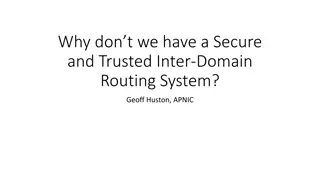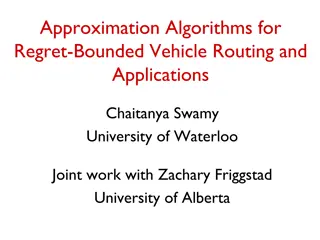Heuristic Approach for the Min-Max Multi-Depot Vehicle Routing Problem
This study explores a three-stage heuristic to solve the Min-Max Multi-Depot Vehicle Routing Problem (MDVRP), aiming to minimize the maximum distance traveled by vehicles. It covers an introduction to the problem, literature review, the importance of the min-max objective, and a heuristic solution methodology involving initialization, local search, and perturbation phases.
Download Presentation

Please find below an Image/Link to download the presentation.
The content on the website is provided AS IS for your information and personal use only. It may not be sold, licensed, or shared on other websites without obtaining consent from the author.If you encounter any issues during the download, it is possible that the publisher has removed the file from their server.
You are allowed to download the files provided on this website for personal or commercial use, subject to the condition that they are used lawfully. All files are the property of their respective owners.
The content on the website is provided AS IS for your information and personal use only. It may not be sold, licensed, or shared on other websites without obtaining consent from the author.
E N D
Presentation Transcript
The Min-Max Multi-Depot Vehicle Routing Problem: Three-Stage Heuristic and Computational Results X. Wang, B. Golden, and E. Wasil POMS -May 4, 2013
Overview Introduction Literature review Heuristic for solving the Min-Max MDVRP Computational results Conclusions 1
Introduction The Min-Max Multi-Depot Vehicle Routing Problem 2
Introduction In the Multi-Depot VRP, the objective is to minimize the total distance traveled by all vehicles In the Min-Max MDVRP, the objective is to minimize the maximum distance traveled by the vehicles 3
Introduction The min-max objective function 4
Introduction Why is the min-max objective important? Applications Disaster relief efforts Serve all victims as soon as possible Computer networks Minimize maximum latency between a server and a client Workload balance Balance amount of work among drivers or across time horizon 5
Literature Review Carlsson et al. (2007) proposed an LP-based balancing approach to solve the Min-Max MDVRP Assignment of customers to vehicles by LP TSP solved by Concorde These steps are repeated and the best feasible solution is returned 6
Solving the Min-Max MDVRP We develop a heuristic (denoted by MD) MD has three phases 1. Initialization 2. Local search 3. Perturbation 7
Phase 1: Initialization Assign customers evenly to vehicles min c x ij ij , i j = t s . . 1 x i ij j n n = + 1 x or j ij m m i , 0 1 , x i j ij Solve a TSP on each route using the Lin- Kernighan heuristic 8
Phase 2: Local Search Step 1. From the maximal route, identify the customer to remove (savings estimation) Customer to remove Savings estimation 9
Phase 2: Local Search Step 2. Identify the route to insert the removed customer (cost estimation) Step 3. Try inserting the customer in the cheapest way Successful go back to Step 1 Unsuccessful try moving another customer Step 4. Stop if we have tried to move every customer on the maximal route 10
Phase 3: Perturbation Perturb the locations of the depots 11
Phase 3: Perturbation Solve the new problem Set the depots back the their original positions Solve the problem and update the solution Repeat the process 12
Computational Results 20 test problems 10 500 customers 3 20 depots Problems have uniform and non-uniform customer locations MD used an Intel Pentium CPU with 2.20 GHz processor Code for LB required a 32-bit machine (Intel Core i5 with 2.40 GHz processor) 13
Computational Results Problem MM8 (3 depots, 200 customers, 2 vehicles) 14
Computational Results Problem MM8 (3 depots, 200 customers, 2 vehicles) 15
Computational Results Uniform Customer Locations MD outperforms the LB-based heuristic by 10.7% on average LB MD Identifier Objective Time (s) Objective Time (s) Improvement (%) MM2 149.225 38.2 131.431 2.80 11.92 MM3 265.349 61.4 236.174 8.20 10.99 MM7 222.071 14.5 189.016 0.74 14.88 MM8 242.730 73.2 215.269 12.56 11.31 MM10 197.594 32.9 197.869 1.33 -0.14 MM11 119.658 78.5 111.067 0.65 7.18 MM12 114.826 37.9 81.300 0.86 29.20 MM13 138.823 35.8 125.268 2.55 9.76 MM14 146.492 35.5 134.476 3.67 8.20 MM15 110.963 41.0 100.074 1.80 9.81 MM16 115.744 60.2 104.125 3.92 10.04 MM18 439.606 68.4 415.777 91.00 5.42 16
Computational Results Non-uniform Customer Locations MD outperforms the LB-based heuristic by 16.2% on average LB MD Identifier Objective Time (s) Objective Time (s) Improvement (%) MM4 569.453 43.9 488.254 57.7 14.26 MM5 398.970 40.2 330.195 7.7 17.24 MM9 183.157 36.8 153.286 38.1 16.31 MM17 325.708 56.8 253.765 84.4 22.09 MM19 474.935 68.4 395.606 155.8 16.70 MM20 385.297 92.1 344.309 74.2 10.64 17
Computational Results On all 20 problems, the running time for MD (596s) is much less than LB (943s) Times for MD are between 0.65s and 156s with most times under 13s Times for LB are between 6s and 92s 18
Computational Results Contribution from improvement procedures 19
Conclusions On the 20 test problems, MD outperforms the LB-based heuristic by 11.27% on average In future work, we hope to apply MD to solve a real-world problem We want to extend our heuristic to solve min- max problems with service times 20























